With Community First and Westpac launching 'zero interest' cards within just days of each other, there are now four interest-free credit cards offered in Australia. Generally, these types of credit cards aim to compete with the popular buy now, pay later (BNPL) sector by offering zero-interest, no late payment fees, and the general flexibility and convenience offered by services like Afterpay and Zip.
As zero-interest credit cards rise in popularity, it’s important to understand what you actually get with these cards. Is there one credit card that stands out from the rest? Or should you stick with your regular credit card?
Zero-Interest Credit Cards Compared
There are four credit cards with 'zero interest' - NAB StraightUp, CommBank Neo, Westpac Flex, and Community First n0w. See how they compare below.
| Brand | Basic Rundown - Credit Limits & Monthly Fee |
| NAB StraightUp |
|
| CommBank Neo |
|
| Westpac Flex |
|
| Community First n0w |
|
NAB StaightUp
NAB launched the first Australian zero-interest credit card back in September 2020, allowing consumers access up to a $3,000 credit limit with no interest or other fees charged. Instead, the card charges flat monthly fees based on the user's credit limit.
The monthly fees are broken down as follows:
-
$1,000 credit limit: $10 monthly fee
-
$2,000 credit limit: $15 monthly fee
-
$3,000 credit limit: $20 monthly fee
Along with the standard monthly fee, the minimum payment required for each card is broken down by credit card limit. For the $1,000 limit, a minimum payment of $35 each month must be made; for the $2,000 limit, it’s $75 per month; and for the $3,000 credit limit, the minimum payment is $110 per month.
Plus, if the card isn’t used and/or has a $0 balance throughout the statement period, the monthly fee is reversed. The card has no international transaction fees, no interest (obviously), and no late fees.
The card also has no complimentary insurance included; you won’t earn reward points with use; no balance transfers; there are restrictions on cash advances and gambling; and you can have no additional card holders.
CommBank Neo
Launching just a day after NAB’s StraightUp credit card, Commonwealth Bank's zero-interest credit card 'CommBank Neo' functions pretty similarly to NAB's product. Featuring zero-interest and no late payment fees, the card functions with one simple monthly fee. Again, consumers can access up to a $3,000 credit card limit with monthly fees based on said limit:
-
$1,000 credit card limit: $12 monthly fee
-
$2,000 credit card limit: $18 monthly fee
-
$3,000 credit card limit: $22 monthly fee
The card's monthly fees are slightly more expensive than NAB’s counterpart but, all in all, it's pretty similar. If you don’t use the card/the balance is paid off in full, the monthly fee doesn’t apply. There’s no interest, no fees, and no international transaction fees. Plus, users could get some cashback benefits through 'CommBank Rewards'.
Again, you won’t earn reward points with this card; international travel insurance isn’t included; there are no balance transfers; and cash advances are generally blocked.
Westpac Flex
Westpac recently announced it will join its fellow big banks, NAB and CommBank, with its own zero-interest credit card. However, it’s somewhat different to the other three credit cards mentioned here. Unlike NAB, CommBank, and Community First, Westpac’s interest-free card is completely digital.
Additionally, it comes with a much lower credit limit than the other cards. While each other card has a credit limit up to $3,000, Westpac Flex only offers up to $1,000 to its users. With this comes a simple $10 monthly fee, which doesn’t apply if there's no outstanding balance, making it on-par with NAB StraightUp.
The card charges no interest, late fees, or foreign transaction fees; it offers fraud protection insurance; and you can access Westpac Extras and Rewards. You can also set up automatic repayments for either the minimum repayment ($40) or the whole amount - whichever suits you.
Community First: n0w Credit Card
That's 'now' with a zero - smart, huh? The most recent zero-interest credit card to join three of the big four is Community First - a credit union - making it the first credit union to launch an interest-free credit card product.
It functions pretty similarly to the first two cards mentioned. No interest, no late fees - just one monthly fee. Slightly cheaper than the rest, the n0w credit card offers up to a $3,000 credit limit to consumers and monthly fees are broken down based on said credit limit.
-
$1,000 credit limit: $9 per month
-
$2,000 credit limit: $14 per month
-
$3,000 credit limit: $19 per month
The minimum repayment is 2.5% per month, or $20. Unlike the other bank offerings, the card has a cash advance feature with a $3 fee to use in Australia and a $5 overseas cash advance fee. It also has a 3% international conversion fee. However, there's not yet a mention of wiping the monthly fee if the balance is paid off.
A four-way comparison: Which credit card is right for you?
Well, which one is the best of the lot? In order to clearly compare the four options you have for zero-interest credit cards, let’s outline the pros and cons of each product. This way, if you’re considering replacing your regular credit card with a zero-interest one, you understand your options.
|
Pros |
Cons |
|
|---|---|---|
|
NAB StraightUp |
|
|
|
CommBank Neo |
|
|
|
Westpac Flex |
|
|
|
Community First 'n0w' |
|
|
Pros and Cons of zero-interest credit cards
Before cutting up your regular credit card and scrapping your BNPL accounts, there are still benefits and drawbacks to consider before opting for a zero-interest credit card. Let’s discuss a few of these to help you decide whether a zero-interest credit card is as good as it sounds, or if it might not be suitable for you.
Pro: No interest charged
Obviously, the main benefit of a zero-interest credit card is there being no interest charged. According to the Reserve Bank of Australia (RBA), the average interest rate for a credit card is 19.94% p.a. So, the idea of scrapping this expense can be pretty appealing.
Pro: No late payment
Another key benefit of zero-interest credit cards is there being no late fee charged. Typical late fees for credit cards can range from $10 to $30 per month. This coupled with interest charges can add up quickly.
Pro: Can be used anywhere, any time
Zero-interest credit cards can be used in store, online, to pay bills - basically to do anything you can do with a regular debit of credit card. This can make a zero-interest credit card more handy than some of the traditional BNPL platforms, because not all merchants accept the same BNPL service. So instead of needing to be signed up with multiple BNPL platforms, you can use your one credit card to cover the costs. Plus, you typically can’t use BNPL to cover things like bills or groceries - but with a credit card, you can.
Con: Might not be as cheap as you think
While the idea of 'no interest' and 'no late fees' might sound appealing, it might not end up being as cost effective as it sounds.
For example, if you used $2,000 of your $3,000 credit limit on your NAB StaightUp card and paid it off by making the minimum repayment ($110) each month, it would take you just over 18 months to pay off your card balance. In this time, you would be charged $360 in monthly fees.
But if you paid this amount off in the same amount of time using a credit card with a 9% p.a. interest rate, with no monthly fees or annual fees, you’d pay $270 in interest charges.
So in this example, by using NAB’s zero-interest credit card, you actually end up paying an additional $90 over a basic, low-interest credit card.
Con: Low credit card limit
In Australia, the average credit card limit is around $9,500 according to the RBA. But there are some credit card limits that range from $20,000 to $100,000. In comparison with the zero-interest credit card options currently available, the credit limits offered are quite low. However, this could be a pro, depending on how you see it - with a lower credit limit, you're given less rope, so to speak, to run with and get in trouble.
Image by Clay Banks on Unsplash




 Brooke Cooper
Brooke Cooper




